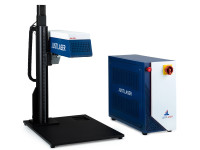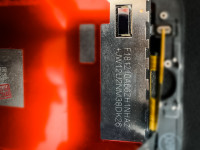Focus on metals
Differences, properties and tips for laser processing
In modern metal processing, it is crucial to know the properties of different metals - especially when precise and economical production methods such as laser cutting are used. Whether steel, stainless steel or aluminum: each of these metals has its own strengths, challenges and processing requirements.
Steel: The robust classic for construction and mechanical engineering
Composition and properties:
Steel is an alloy of iron and carbon (0.02-2.1%) - often supplemented with manganese, nickel or chromium to optimize hardness, strength or toughness. Typical trade designations such as S235 or C45 provide information about yield strengths and material properties.
- Surface appearance: Steel typically appears matt and gray in its raw form, sometimes with a bluish or slightly greenish sheen. Untreated steel tends to rust without a protective coating, which is visible in reddish or brownish rust spots.
- Magnetism: Most types of steel are magnetic, which often serves as a simple identification test.
- Weight & density: With a density of around 7.85 g/cm³, steel is heavier than light metals such as aluminum.
- Surface structure: Visible machining marks, weld seams or mechanical processing (e.g. rivets and spot welds) may be present.
Commercial designations:
- Construction steel: Often designated with standards such as S235, S355 (the numbers indicate the minimum yield strength in N/mm²).
- Tool steel: Designations such as C45, H13 etc.
- Quenched and tempered or case-hardened steels: With specific designations indicating the alloy and heat treatment.
Typical properties & applications:
- High strength and resilience
- Good weldability (depending on the grade)
- Widely used in mechanical engineering, construction, automotive industry, shipbuilding and general construction
Laser cutting of steel:
Steel can be cut efficiently with lasers. Oxygen as a cutting gas ensures fast, oxidizing cuts, while nitrogen provides clean, oxide-free edges. With thicker sheets, the heat effect should be carefully observed to avoid distortion.
Stainless steel: Corrosion-resistant, hygienic and durable
Composition and properties:
Stainless steel is defined by a chromium content of 10.5% or more. Variants such as V2A (1.4301) and V4A (1.4401/1.4571) often also contain nickel and molybdenum - ideal for aggressive or damp environments.
Recognizable features:
- Surface appearance: Stainless steel is characterized by a shiny, often reflective surface that is very homogeneous and aesthetically pleasing. Even after prolonged use, stainless steel generally shows no rust stains or discoloration, as the chromium oxide layer protects against corrosion.
- Magnetism: Depending on the alloy (e.g. austenitic stainless steel types such as 1.4301), stainless steel can be non-magnetic. Other types, such as ferritic or martensitic stainless steels, are magnetic.
- Weight & density: The density is similar to that of structural steel (approx. 7.8-8.0 g/cm³), but often gives a more noble impression due to the high-quality alloying elements.
- Reaction behavior: Stainless steel hardly reacts with environmental influences, which makes it ideal for hygienic and corrosive environments.
Standard commercial designations:
- V2A (1.4301): Frequently used in kitchens, in the food industry and in interior fittings.
- V4A (1.4401/1.4571): Contains additional molybdenum and is used in maritime applications and in aggressive environments.
- Formats: Sheets, rods, tubes and profiles in various production states.
Typical properties & applications:
- Excellent corrosion resistance, even under moist or chemically aggressive conditions
- Good hygiene and cleaning properties
- Used in architecture, chemical plant construction, medical technology, vehicle construction and decorative applications
Laser cutting of stainless steel:
High precision and brilliant cutting edges are standard when laser cutting stainless steel - provided that nitrogen is used as the cutting gas. The lower thermal conductivity ensures clean cuts, but requires precise laser parameters.
Aluminum: Lightweight, versatile and technically sophisticated
Composition and properties:
At 2.7 g/cm³, aluminum is significantly lighter than steel or stainless steel. The natural oxide layers offer good corrosion protection. Pure aluminum (e.g. EN AW-1050) and alloys (e.g. EN AW-6061) are widely used.
- Surface appearance: In its natural form, aluminum appears silvery-white and shiny. Thanks to the natural oxide layer, the surface often has a uniform appearance and can also be anodized to achieve different colors.
- Magnetism: Aluminum is non-magnetic, which is a clear distinguishing feature compared to steel and some stainless steels.
- Weight & density: Significantly lighter than steel and stainless steel, which is particularly noticeable in lightweight constructions.
- Formability & reflection: Due to its lightness and flexibility, aluminum is preferred in many areas of application. Its surface reflects light and laser beams strongly, which must be taken into account during processing.
Standard commercial designations:
- Pure aluminum: For example, EN AW-1050 (over 99% aluminum content).
- Aluminum alloys: Markings such as EN AW-6061, EN AW-6082, etc., which reflect specific alloy properties.
- Formats: Sheets, profiles, tubes and castings.
Typical properties & applications:
- Very light yet relatively strong, especially in alloyed form
- Excellent thermal and electrical conductivity
- Widely used in the aerospace, automotive, construction, packaging and electrical industries
Laser cutting of aluminum:
Due to its high reflection, aluminum is a challenge in laser material processing. It requires powerful fiber lasers and special safety measures. Nitrogen prevents oxidation at the edges - but reworking is often necessary due to possible burrs.
Conclusion: Not all metals are the same - and this is crucial for your processing
For metal processors, knowledge of material properties is more than just theory - it determines efficiency, quality and cost-effectiveness in production. Modern laser machines enable high-precision cutting of steel, stainless steel and aluminum - but optimum results can only be achieved with the right know-how.
With laser machines from JustLaser, you benefit from the latest technology, specially tailored to your metal processing requirements - from prototype to series production.



